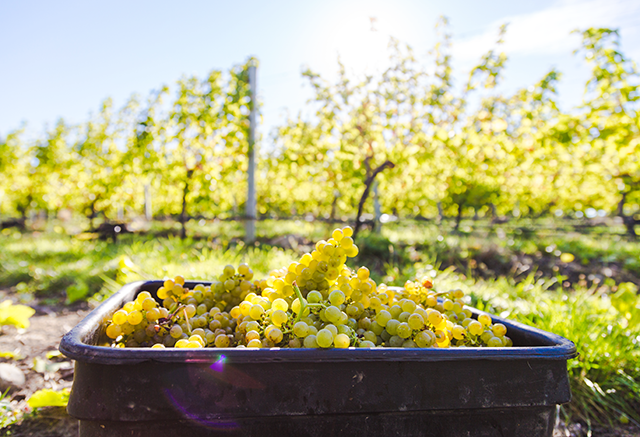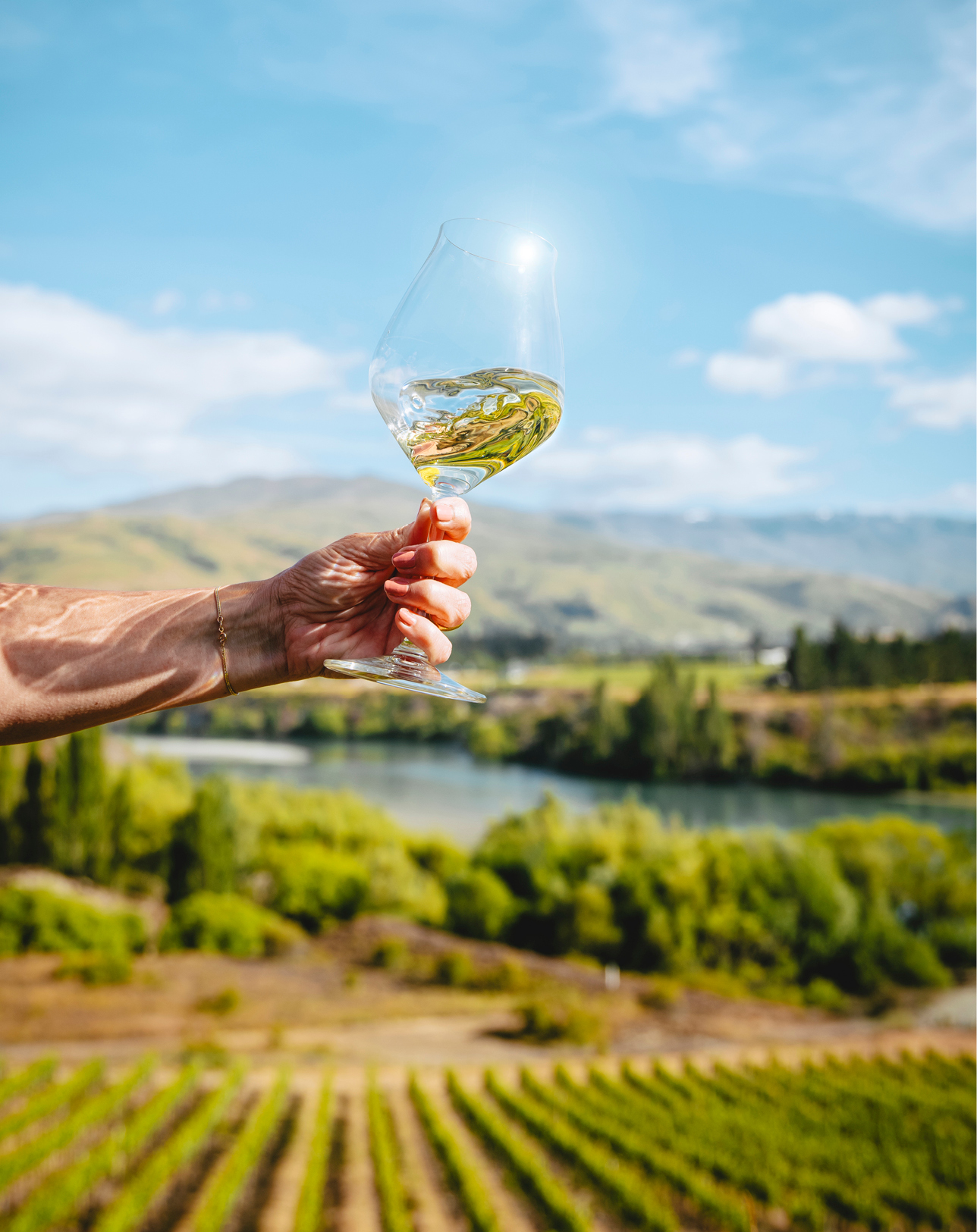Here’s a synopsis of New Zealand’s best known white wines and some up-and-coming varieties making a mark on the global scene:
Sauvignon Blanc
New Zealand is synonymous with Sauvignon Blanc and produces some of the world’s best. The variety, which can be thanked for alerting the world to New Zealand’s excellent wine growing capability, now accounts for over 85% of the country’s wine exports.
Critics continue to be blown away by the unique, intense flavours that set New Zealand Sauvignon Blanc apart. Climate is the major factor in defining styles which range from richer, riper stone fruit flavours out of the warmer northern regions to stronger, more pungent styles from the cooler south where the wine has higher levels of acidity and added notes of tropical fruits, red pepper (capsicum) and gooseberry characters.
Only produced commercially since the 1970s, Sauvignon Blanc is now the country’s most widely planted variety and although grown throughout New Zealand, 90% of total production comes from Marlborough in the north eastern region of the South Island.
Chardonnay
Once the most planted grape variety in New Zealand and the fashionable wine of choice during the 1990s, New Zealand Chardonnay has evolved to be more about quality not quantity. It now ranks fourth in acreage and makes up around 6% of New Zealand wine production.
The bold and buttery, barrel-aged wines that won winemakers acclaim in the early days have evolved to be more refined, fruity and fresh with a complexity and style that’s uniquely New Zealand.
Chardonnay is known as the winemaker’s grape because of its relatively neutral and adaptable nature and New Zealand producers, passionate about their wines, are creating top quality wines in every region.
Pinot Gris
Breaking on to the New Zealand scene in the early 1990s, Pinot Gris has enjoyed a dramatic rise to fame and is now New Zealand’s third most popular white variety.
Grown right across the country, New Zealand Pinot Gris is closer to the French style of Alsace and is a fresh and full-flavoured wine with notes of apple, pear, honeysuckle, spice and bread. With annual production now exceeding 28,000 tonnes, Pinot Gris makes up 6% of New Zealand’s total wine production.
Riesling
Riesling only began to be planted in volume in New Zealand during the 1980s and has since risen to the fourth most popular white wine variety.
Over 90% is grown in the South Island, where the climate is ideally suited with cool, long, dry, sunny autumns, large diurnal variance and low humidity.
Styles range from bone dry to lushly sweet and the regional influence on flavour includes stone fruit and spice characters from sunny Nelson; lemon and lime from Marlborough; and green apples, minerality and citrus from the cooler North Canterbury and Central Otago regions.
Gewürztraminer
The volumes of Gewürztraminer produced in New Zealand are tiny but a handful of dedicated and passionate producers throughout the country are successfully making smooth, subtle and extremely fragrant Gewürztraminer of note.
As a naturally lower acid variety, this grape appreciates New Zealand’s overall cooler climate and free-draining soils, while plentiful sunshine and significant diurnal shifts emphasize the aromatic purity and fruit richness of the variety. Styles vary in dryness from bone dry to a sweet late harvest.
Sparkling
The production of sparkling wines from New Zealand is small but critically renowned.
Traditional winemaking techniques, combined with New Zealand’s cool climate and plentiful sunshine, produce impressively high quality sparkling wine and balanced, well-structured wines can be found across a wide range of styles. They are predominantly Méthode Traditionnelle, but the range also includes aromatic styles like Sparkling Sauvignon Blanc.
Hallmark characteristics include nutty, biscuity aromas, balanced with fresh acidity and fruit.
Other varieties:
Albariño– 27ha
Hailing from Galicia in north-western Spain, Albariño has made a happy home in New Zealand, and is now found throughout the country's regions, with more concentrated plantings developing in Gisborne, Marlborough and Hawke's Bay.
Arneis – 33ha
The preeminent white wine of Italy's Piedmont region, Arneis was first planted in New Zealand in 1998 at Clevedon. Since then there's been steady interest from producers with vines now found predominantly in Hawke's Bay, Gisborne and Marlborough.
Chenin Blanc – 22ha
A wonderfully versatile grape, Chenin Blanc has inspired much loyalty from the handful of New Zealand producers who have fallen for its complexity, longevity and deliciousness. New Zealand's cool climate and high sunshine hours ably deliver Chenin's hallmark acidity alongside rich flavours of apple, quince, floral and honey notes. A range of styles is produced from fresh and dry through to lusciously sweet late harvest wines.
Grüner Veltliner – 46ha
An Austrian native producing pale green wines with citrus, white peach and slight musky complexity, Grüner also has distinctive white pepper and herbal notes (most often dill, gherkin or cooked celery) and refreshing acidity. Grown from Gisborne to Central Otago and everywhere in between, New Zealand's style appears to be emerging as fresh, fruit-forward and varietally faithful with good depth.
Viognier – 119ha
This French variety is gaining increasing popularity in New Zealand providing an alternative to Chardonnay and Pinot Gris. Wines vary in style from light and fresh to full-bodied and textural, but generally display ripe apricot, peach, orange blossom, jasmine and spice notes. Plantings are mainly concentrated in Hawke's Bay and Waiheke Island, where occasionally Viognier is also added in tiny amounts to their Syrah, providing additional perfume and lift.
Pinot Blanc -11ha
A member of the wider Pinot family (i.e. Noir and Gris), there's just a smattering of the versatile white Pinot Blanc grown throughout New Zealand, and much of its production is blended into other white wines. When made individually, however, New Zealand's cool, sunny climate highlights soft stone fruit and apple with a hint of citrus and spice aromas and flavours.
Sauvignon Gris – 113ha
No, not a mixture of those popular Sauvignon Blanc and Pinot Gris varieties, but a bona fide variety in its own right (albeit from a clonal mutation of Sauvignon Blanc). Sauvignon Gris does, however, share a similar vivacious fruitiness and medley of fruity, fresh herbal and ripe stone fruit aromas and flavours. Grown mainly in Marlborough, where it is made in dry to off-dry fruit-focused styles.
Semillon – 48ha
Much of the Semillon grown throughout New Zealand is used in blends, where it can add extra depth to Sauvignon Blanc amongst others. However, a few producers with especially suitable sites make wines ranging from dry, full-bodied and fresh-fruited examples through to decadently sweet dessert styles. All retain hallmark vibrant lemon, lime, apple and melon-rich fruit alongside cleansing acidity.
Verdelho – 7ha
Wines from the tiny New Zealand plantings of Portuguese white variety Verdelho can be hard to find but when you do, they are great matches for local seafood. Typically fresh and fruity in style, with light mandarin, honeysuckle and passionfruit notes plus a dash of minerality.


























